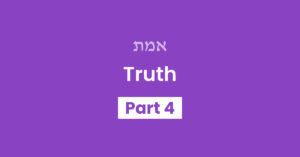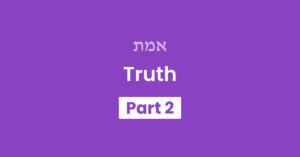We have been focusing this month on the middah of Emes (truth). So far, we discussed how it’s important to speak only the truth, because Hashem loves when we speak the truth, and speaking the truth builds trust between people.
Just as speaking the truth to other people makes us trustworthy in their eyes, whenever we speak the truth to ourselves, we build up our own sense of trust in ourselves. We must take our own words seriously and truthfully by sticking to our resolutions and following through with our commitments.
As we mentioned earlier, Chazal teach us that Hashem’s “signature” is Emes1. This is quite a mysterious teaching. What does it mean that Hashem’s “signature” is Truth? And why isn’t Hashem’s signature one of His other amazing middos, such as Chessed (kindness), or Chochmah (wisdom)?
What does it mean that Hashem’s “signature” is Truth?
In order to understand what it means that Hashem’s signature is “Truth,” let’s first try to understand what a signature represents.
Every Signature Is Unique
A signature is a unique way to identify someone. Even if someone else has the same name as you, they will never have exactly the same signature. You have a unique way of holding your pen, putting pressure on the paper, and shaping your letters. No one else can perfectly copy your signature. It’s unique to you.
Therefore, when Chazal say that Hashem’s signature is “Emes,” it means that Emes belongs only to Hashem. Hashem is the only Emes (truth) and nothing else is Emes.
Hashem is the only Emes (truth) and nothing else is Emes.
But what does that mean? Can’t I tell the truth also?
The Sifsei Chaim2 explains that “Emes” doesn’t just mean speaking true words which accurately describe reality. On the deepest level, Emes means BEING reality.
When we say that “Hashem is the only Emes,” we mean that Hashem is the only One whose existence will always be true. Hashem existed before this world was ever created, and Hashem will continue to exist forever. His existence is eternal, everlasting, and unchanging – and will always be true.3
Hashem is the only One whose existence will always be true.
By contrast, our own physical existence is inherently transient, and we have no guarantee of existing forever. As we explained earlier, everything in this world – including us – can be compared to a slice of pizza that you’re daydreaming about during class. As long as you’re dreaming about the pizza, the pizza “exists” in your imagination. But as soon as you snap out of your daydream, the pizza will instantly cease to exist.
So too, we human beings can only continue to exist as long as Hashem is “thinking” about us and purposely deciding to pump life energy into us. If Hashem would stop thinking about us for even one second, chas veshalom, we would immediately cease to exist.4 Hashem’s existence is the ONLY true existence, and we are just like transient figments of His imagination. Our existence is totally dependent on Him.
Hashem’s existence is the ONLY true existence, and we are just like transient figments of His imagination.
We can now understand what it means that Hashem’s signature is Emes. While most middos of Hashem are middos that we can emulate to some degree, there is one middah that belongs to Hashem alone. That middah is Emes. We, as physical human beings, can never fully embody the middah of Emes because our existence will always be transient, and dependent on Hashem to continue. We have no power to guarantee our own existence, so our existence is not fully stable and true.
Connecting to Emes
Even though our own existence is inherently unstable and not guaranteed, there is one way that we can still tap into Hashem’s middah of Emes, and earn an everlasting existence for ourselves as well. The way to do it is by connecting to Hashem.
Whenever we connect to Hashem, we are connecting to His everlasting Emes.5 Just as a person drowning in the water can grab on to someone else’s outstretched hand in order to save himself from death, we, too, can grab on to Hashem in order to connect ourselves to eternal Life. The more we cling to Hashem, the more we are attached to Hashem’s eternal, everlasting existence.
Whenever we connect to Hashem, we are connecting to His everlasting Emes.
This is what Moshe Rabbeinu meant when he told the Jewish people: “V’Atem HaDveikim BaHashem Elokeichem Chayim Kulchem HaYom – And you, who are clinging to Hashem, your G-d, you are all alive today.”6 Whoever clings to Hashem is clinging to life, and whoever “lets go” of Hashem is allowing himself to fall into the transient, unreliable, temporary existence of this physical world.
This is also what is meant by the bracha said after a person gets an aliyah: “Baruch Atah Hashem… Asher Nasan Lanu Toras Emes, V’Chayei Olam Nata B’Socheinu – Blessed are You, Hashem… Who gave us the Torah of Emes, and implanted within us eternal life.“ We are thanking Hashem for giving us the Torah, because only through learning Torah and performing mitzvos can we attach ourselves to Hashem’s eternal reality.
This week, let’s work on acquiring eternity for ourselves by doing mitzvos and attaching ourselves to Hashem who is the only true, everlasting reality.
Sources: [1] Shabbos 55a; [2] Sifsei Chaim Middos Vol. 1. pgs 30-35; [3] See Yeshaya 44:6; [4] See Rambam Hilchos Yesodei HaTorah 1:2 and Nefesh HaChaim Shaar 1 Perek 2; [5] Sifsei Chaim Middos Vol. I. pg. 34; [6] Devarim 4:4
Your Challenge
Once a day, while doing a mitzvah, think something like:
“This mitzvah is helping me connect to Hashem and attach myself to eternity, because Hashem is the only true, everlasting reality.”
For example, you can think about this while doing any of the following mitzvos:
- Washing netilas yadayim
- Cleaning/cooking/preparing for Shabbos
- Giving Tzedaka
- Helping a parent (Kibbud Av V’Aim)
- Learning Torah
- Doing an act of chessed to help someone else
- Going to daven
Torah Questions
- Who was looking for “people of truth” in Shemos Perek 18?
- How does Rashi define “Anshei Emes” in the above context?
- There are 3 consecutive words at the very beginning of Bereishis, which can spell “Emes” if you take the last letter of each word and then re-arrange them. What are the 3 words?
- According to Rashi (Bereishis 47:29), what is “Chessed shel Emes”?
- According to Mishlei 12:19, how long will truth last, and how long will falsehood last? (See Metzudas Tziyon)
- Which animal in Perek Shira says a passuk that includes the word “Emes”?
Questions to Ponder
- The Gemara (Shabbos 10a) writes that any judge who judges truthfully is considered as if he is a partner with Hashem in creating the world! How could that be? What does that mean?
- Rashi on Tehillim 85:11 writes that when the Jewish people speak truthfully, Hashem will do chessed with them. Why is that a fitting reward for speaking the truth?
- Chazal point out that Emes (truth) comes from the same root as Emunah (belief). What does What does truth have to do with belief?
- Pirkei Avos (1:18) says that the world stand on 3 thing: Emes (truth), Mishpat (justice) and Shalom (peace). But a different Mishna in Prikei Avos (1:2) says that the world stands on Torah, Avodah, and Gemilus Chassadim. Are these 2 Mishnayos contradicting each other? Can you resolve the contradiction somehow?




